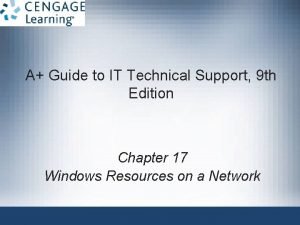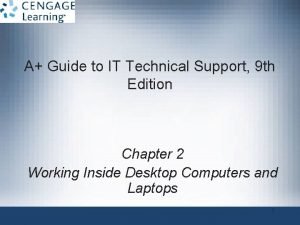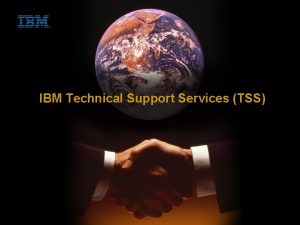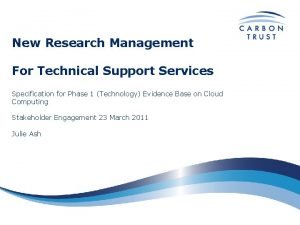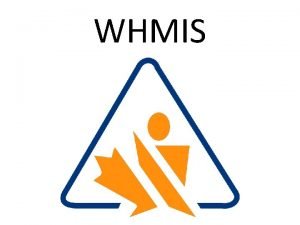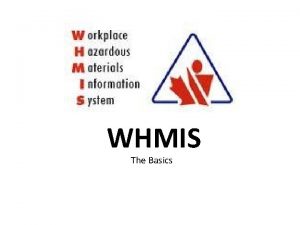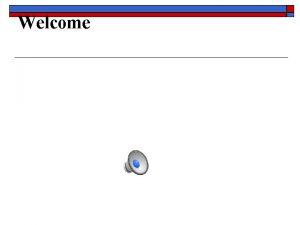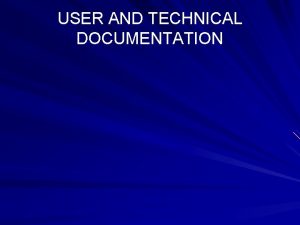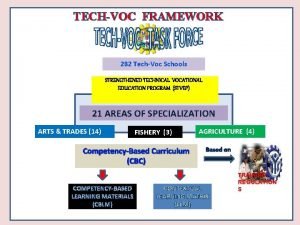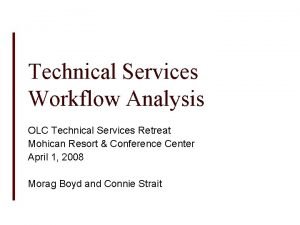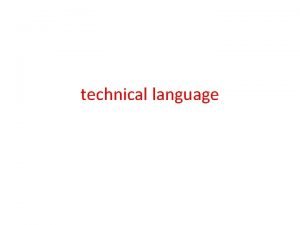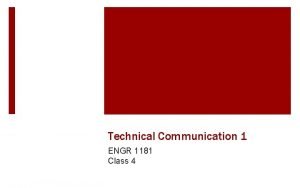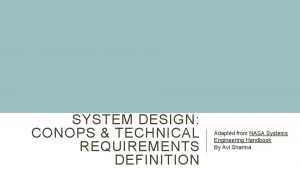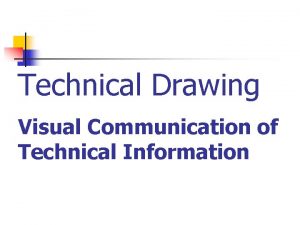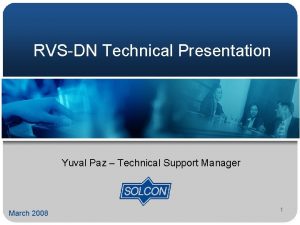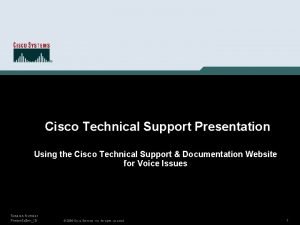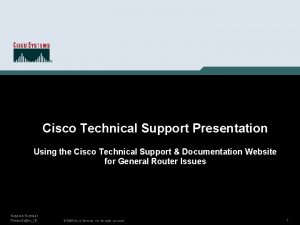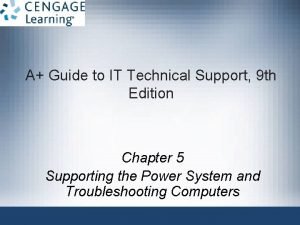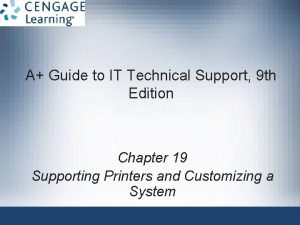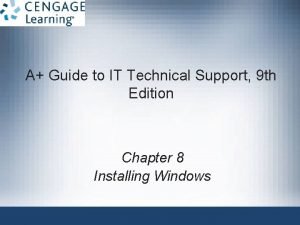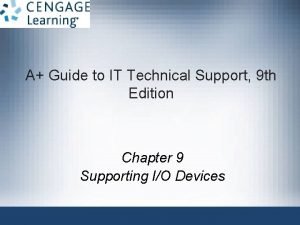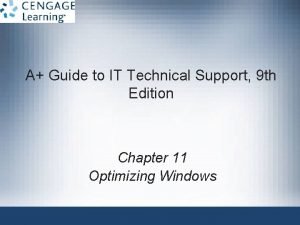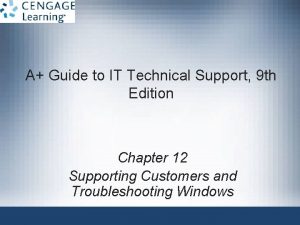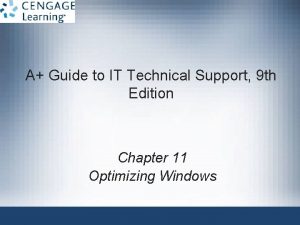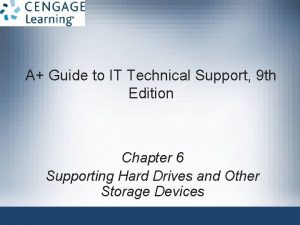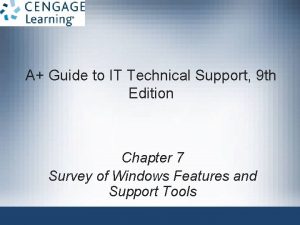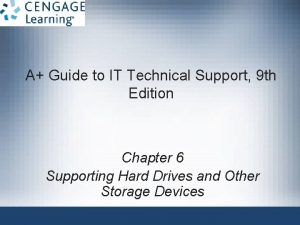A Guide to IT Technical Support 9 th


















































- Slides: 50

A+ Guide to IT Technical Support, 9 th Edition Chapter 17 Windows Resources on a Network

Objectives • Support some client-server applications • Share and secure files and folders on a network • Support cloud computing services on a network A+ Guide to IT Technical Support, 9 th Edition 2 © Cengage Learning 2017

Supporting Client/Server Applications • Client/Server applications expected to support: – Internet Explorer – Remote Desktop – Other remote applications • Also need to know how to use Group Policy to configure Quality of Service (Qo. S) – Also how to link a data source through a network to database applications A+ Guide to IT Technical Support, 9 th Edition 3 © Cengage Learning 2017

Network Servers • List of popular client-server resources: – – – – Mail server File server Print server DHCP server DNS server Proxy server Authentication server Web server A+ Guide to IT Technical Support, 9 th Edition 4 © Cengage Learning 2017

Internet Explorer • Most popular client/server applications are a browser and web server • Internet Explorer (IE) version 11: latest version at this writing – Windows 10 features new Microsoft Edge browser • Easy to upgrade by using Windows Update • Tips when using IE window: – To show the menu bar, press the Alt key – HTTP Secure – look for https and a padlock icon – If you have problems with IE 11, you can disable it A+ Guide to IT Technical Support, 9 th Edition 5 © Cengage Learning 2017

Internet Explorer • Use the Internet Options box to manage IE settings – Click Tools icon and click Internet Options • Internet Options box has several tabs with different configuration options and settings • General Tab – Change the home page or add a second home page – Protect your identity and surfing records – Check Delete browsing history on exit if you want your history cleared each time you close IE – Manage IE cache A+ Guide to IT Technical Support, 9 th Edition 6 © Cengage Learning 2017

Internet Explorer • Security Tab – Set security level (medium-high is the default level) • Prompts before downloading content • Does not download Active. X controls that are not signed by Microsoft (virus can sometimes hide in an Active. X control) – To customize security settings, click Custom level A+ Guide to IT Technical Support, 9 th Edition 7 © Cengage Learning 2017

Internet Explorer • Privacy Tab and Content Tab – Use Privacy Tab to block cookies that might invade your privacy or steal identity – Content tab contains settings for Family Safety, certificates used by web sites, and how Auto. Complete and Feeds are handled A+ Guide to IT Technical Support, 9 th Edition 8 © Cengage Learning 2017

Internet Explorer • Connections Tab and Proxy Settings – Allows you to configure proxy server settings and create a VPN connection • Proxy server: intercepts requests that a browser makes of a server and serves up request from a cache it maintains Figure 17 -8 Enter the IP address of all proxy servers on your corporate network A+ Guide to IT Technical Support, 9 th Edition 9 © Cengage Learning 2017

Internet Explorer • Programs Tab – Used to manage add-ons (plug-ins) • Add-ons: small apps that help IE display multimedia content, manage email, translate text, or other actions Figure 17 -9 Use the Programs Tab to manage add-ons and default applications used for Internet services A+ Guide to IT Technical Support, 9 th Edition 10 © Cengage Learning 2017

Internet Explorer • Advanced Tab – Contains several miscellaneous settings used to control Internet Explorer – One setting is useful when IE is giving problems • If you suspect problems are caused by wrong settings, click Reset to return IE to all default settings A+ Guide to IT Technical Support, 9 th Edition 11 © Cengage Learning 2017

Remote Desktop Connection (RDC) • Remote Desktop gives a user access to a Windows desktop from anywhere on the Internet • To use Remote Desktop, the computer you want to remotely access (the server) must be running business or professional editions of Windows 8/7/Vista – Computer accessing can be running any version of Windows • Computers set to serve up Remote Desktop are not as secure – You can use software that does not require opening ports for a more secure solution A+ Guide to IT Technical Support, 9 th Edition © Cengage Learning 2017 12

Remote Assistance • Remote Assistance – a user on the server computer can remain signed in during the remote session, retains control of the session, and can see the screen – Helpful when troubleshooting problems – User who needs help send an invitation by email or chat to connect to their computer using Remote Assistance A+ Guide to IT Technical Support, 9 th Edition 13 © Cengage Learning 2017

Remote Assistance • Ways to initiate a Remote Assistance session: – User saves an invitation file and send file to technician – User can send an automated email through the Remote Assistance app – User can use Easy Connect, which is the easiest method to start Remote Assistance connection • Both computers must support Easy Connect – Technician can initiate a session • Follow steps outlined in text to see how to initiate a Remote Assistance connection using Easy Connect A+ Guide to IT Technical Support, 9 th Edition 14 © Cengage Learning 2017

Remote Assistance • Things you can do during a Remote Assistance session: – – – Chat Request control Pause Disconnect or Stop sharing Log activity in a log file Change expiration of invitations A+ Guide to IT Technical Support, 9 th Edition 15 © Cengage Learning 2017

Remote Assistance • If you have problems making the connection: – Windows Firewall on the user’s computer might be blocking Remote Assistance • Verify Remote Assistance is checked as an exception to blocked apps in Windows Firewall window – If outside the user’s local network, the hardware firewall protecting her network might be blocking Remote Assistance • Verify that port forwarding is enabled for Remote Assistance A+ Guide to IT Technical Support, 9 th Edition 16 © Cengage Learning 2017

Use Group Policy to Improve Qo. S Applications • Group Policy (gpedit. msc) – Used to control what users can do and how the system can be used – Only available in Windows professional and business editions – Works by: • Making entries in registry • Applying scripts to Windows startup, shutdown, and logon processes • Affecting security settings A+ Guide to IT Technical Support, 9 th Edition 17 © Cengage Learning 2017

Use Group Policy to Improve Qo. S Applications • Group Policy (cont’d) – Can be applied to computer or user • Computer policies are applied just before logon screen • User policies are applied after login – To use Group Policy to set the Qo. S level for an application follow steps outlined in the text – To get the most out of Qo. S, configure each router and computer on the network to use Qo. S A+ Guide to IT Technical Support, 9 th Edition 18 © Cengage Learning 2017

Use Group Policy to Improve Qo. S Applications • Important options when creating a policy: – Priority level is determined by a DSCP (Differentiated Service Code Point) value – Outbound traffic can be throttled to limit the bandwidth assigned an application – The policy can apply to all applications or a specific program – You can specify the source IP address and/or destination IP address – You can select the protocol (TCP or UDP) and port numbers for the policy A+ Guide to IT Technical Support, 9 th Edition 19 © Cengage Learning 2017

ODBC Data Sources • Open Database Connectivity (ODBC) – technology used to create the data source – Which provides access to the database and includes the drivers required to interface between Access and the data – Drivers for Microsoft SQL Server must be installed on the local computer – Use the ODBC Data Sources tool in the Administrative Tools group of Control Panel to configure the data source A+ Guide to IT Technical Support, 9 th Edition 20 © Cengage Learning 2017

Controlling Access to Folders and Files • Managing shared resources is accomplished by: – Assigning rights to user accounts – Assigning permissions to folders and files A+ Guide to IT Technical Support, 9 th Edition 21 © Cengage Learning 2017

Classify User Accounts and User Groups • Principle of least privilege: An approach where computer users are assigned the minimum rights required to do their job • Rights or privileges are established when you first create a user account (based on account type) – Rights can later be changed by changing the user groups to which the account belongs • User accounts are created from the Control Panel or by using the Computer Management console A+ Guide to IT Technical Support, 9 th Edition 22 © Cengage Learning 2017

Classify User Accounts and User Groups • Type of User Account – Administrator account: has complete access to the system and can make changes that affect the security of the system and other users – Standard user account: can use software and hardware and make some system changes but cannot make changes that affect the security of the system or other users A+ Guide to IT Technical Support, 9 th Edition 23 © Cengage Learning 2017

Classify User Accounts and User Groups Figure 17 -29 Create a new user A+ Guide to IT Technical Support, 9 th Edition 24 © Cengage Learning 2017

Classify User Accounts and User Groups • Built-in User Groups – Administrators and Users groups – Guests group • Has limited rights and is given a temporary profile that is deleted when user logs off – Backup Operators group • Can back up and restore files on the system regardless of its access permission to files – Power Users group • Windows XP group that can read from and write to parts of the system, install apps, and perform limited administrator tasks A+ Guide to IT Technical Support, 9 th Edition 25 © Cengage Learning 2017

Classify User Accounts and User Groups • Windows might automatically assign one of these built-in user groups to an account: – Authenticated Users group: includes all user accounts except the Guest account – Everyone group: includes the Authenticated Users group as well as the Guest account – Anonymous users: users who have not been authenticated on a remote computer A+ Guide to IT Technical Support, 9 th Edition 26 © Cengage Learning 2017

Classify User Accounts and User Groups • Customized User Groups – Use Management Console in business and professional editions of Windows to create custom user groups – Easier to assign permissions to user groups rather than to individual accounts • User groups work well when several users need the same permissions • Create a user group and then assign permission to the user group A+ Guide to IT Technical Support, 9 th Edition 27 © Cengage Learning 2017

Methods to Assign Permissions To Folders and Files • Three general strategies for managing shared folder and files in Windows – Homegroup sharing: use when all users on a network require the same access to all resources – Workgroup sharing: offers better security than a homegroup – Domain controlling: if computer belongs to a domain, all security is managed by the network administrator for the entire network A+ Guide to IT Technical Support, 9 th Edition 28 © Cengage Learning 2017

Methods to Assign Permissions To Folders and Files • Tips on which folder to use to hold shared data: – Private data for individual users • C: Users folder for that user – Data for all users to share • C: UsersPublic folder – For best security, create a folder not in either of the above folders and assign permissions to that folder and its subfolders • Allow all users access or only certain users or user groups A+ Guide to IT Technical Support, 9 th Edition 29 © Cengage Learning 2017

Methods to Assign Permissions To Folders and Files • Using workgroup sharing, Windows offers two methods to share a folder – Share permissions: grant permissions only to network users and not to local users • Apply to a folder and its contents, not to individual files – NTFS permissions: apply to local users and network users • Apply to both folders and individual files • Work on NTFS volumes only A+ Guide to IT Technical Support, 9 th Edition 30 © Cengage Learning 2017

Methods to Assign Permissions To Folders and Files • Tips when implementing permissions: – If both share and NTFS permission are used, the most restrictive permission applies – If NTFS permissions are conflicting the more liberal permission applies – Permission propagation: when permissions are passed from parent to child – Inherited permissions: permissions attained from a parent object – When you move or copy an object to a folder, the object takes on permissions of that folder A+ Guide to IT Technical Support, 9 th Edition 31 © Cengage Learning 2017

How to Share Folders and Files • User and Group Information with the gpresult Command – Use the gpresult command to pull a list of all the groups a user belongs to – Information can be helpful when troubleshooting user group issues or Group Policy problems – Enter the command gpresult/scope user/username /r to retrieve information on a user other than the one signed in A+ Guide to IT Technical Support, 9 th Edition 32 © Cengage Learning 2017

How to Share Folders and Files • How to Use Share Permission – For NTFS volume, use NTFS permission whenever possible Figure 17 -45 Use the sharing tab of a folder properties box to set up share permissions on a FAT volume A+ Guide to IT Technical Support, 9 th Edition 33 © Cengage Learning 2017

Support and Troubleshoot Shared Folders and Files • Few tips about managing shared folders and files: – Use advanced permissions settings if you need further control of a user or group • Click Advanced on the Security tab of a folder’s Properties box – Manage permissions using parent folder • Subfolders inherit permissions of the parent folder – Check the effective permissions • To know for sure which permissions are in effect, see Effective Permissions tab of Advanced Security Settings box A+ Guide to IT Technical Support, 9 th Edition 34 © Cengage Learning 2017

Support and Troubleshoot Shared Folders and Files • Few tips about managing shared folders and files: (cont’d) – Take ownership of a folder • Owner of a folder always has full permissions – Use only one workgroup • Performance improves when they are all in the same workgroup – Require passwords for all user accounts – Use a mapped network drive A+ Guide to IT Technical Support, 9 th Edition 35 © Cengage Learning 2017

Support and Troubleshoot Shared Folders and Files Figure 17 -50 Change the owner of a folder A+ Guide to IT Technical Support, 9 th Edition 36 © Cengage Learning 2017

How to Map a Network Drive or Network Printer • A network share is one of the most powerful and versatile methods of communicating over a network – Makes one computer (the client) appear to have a new hard drive, such a drive E, that is really hard drive space on another host computer – Called mapping a drive • Network File System (NFS) makes it possible for files on the network to be accessed as easily as if they are stored on the local computer A+ Guide to IT Technical Support, 9 th Edition 37 © Cengage Learning 2017

Hidden Network Resources and Administrative Shares • To protect confidential data from users on the network: – Disable File and Printer Sharing – Hide a shared folder • If you want to share a folder, but don’t want others to see it add a $ to the end of the folder name • Those that want to access the hidden folder must enter the complete path to the folder (including $) in search box A+ Guide to IT Technical Support, 9 th Edition 38 © Cengage Learning 2017

Hidden Network Resources and Administrative Shares Figure 17 -54 (a) A $ on the share name hides the share unless the exact name is used to locate it; (b) access a hidden, shared folder on the network by searching for its exact name A+ Guide to IT Technical Support, 9 th Edition 39 © Cengage Learning 2017

Hidden Network Resources and Administrative Shares • Local shares: folders and files on a computer that are shared with others using local user accounts • Administrative shares: folders that are shared by default that administrator accounts at the domain level can access – Two types of administrative shares: • The %systemroot% folder • Any volume or drive • Don’t share the /Windows folder or an entire drive – Don’t want system files and folders exposed A+ Guide to IT Technical Support, 9 th Edition 40 © Cengage Learning 2017

Cloud Computing • Cloud computing – when a third-party service or vendor makes computer resources available to its customers over the Internet • Can provide many other types of resources: – – – Applications Network services Websites Database servers Specialized developer applications Entire operating systems A+ Guide to IT Technical Support, 9 th Edition 41 © Cengage Learning 2017

Cloud Computing • All cloud computing service models incorporate the following elements: – – – Service at any time Elastic services and storage Support for multiple client platforms Resource pooling and consolidation Measured service A+ Guide to IT Technical Support, 9 th Edition 42 © Cengage Learning 2017

Cloud Computing Categories • Cloud computing service models are categorized by the types of services they provide: – Iaa. S (Infrastructure as a Service) – customer rents hardware, including servers, storage, and networking – Paa. S (Platform as a Service) – customer rents hardware, operating systems, and some applications that might support other applications installed – Saa. S (Software as a Service) – customers rent hardware, operating systems, and applications specific to the customer’s needs • Applications are provided through an online user interface A+ Guide to IT Technical Support, 9 th Edition 43 © Cengage Learning 2017

Cloud Computing Categories • Cloud computing service models are categorized by the types of services they provide (cont’d): – Xaa. S (Anything as a Service or Everything as a Service) – the “X” represents an unknown • Cloud can provide any combination of functions • Another Saa. S implementation that doesn’t fit the official definition of Saa. S is rentable software or software by subscription – Many companies are moving toward this subscription model A+ Guide to IT Technical Support, 9 th Edition 44 © Cengage Learning 2017

Cloud Computing Categories Figure 17 -57 At each progressive level, the vendor takes over more computing responsibility for the customer A+ Guide to IT Technical Support, 9 th Edition 45 © Cengage Learning 2017

Deployment Models for Cloud Computing • Cloud computing deployment models: – Public cloud – services are provided over the Internet to the general public – Private cloud – services are established on an organization’s own servers • Or established virtually for a single organization’s private use – Community cloud – services are shared between multiple organizations, but not available publicly – Hybrid cloud – a combination of public, private, and community clouds used by same organization A+ Guide to IT Technical Support, 9 th Edition 46 © Cengage Learning 2017

Chapter Summary • A client computer contacts a server to request information or to perform a task • The Internet Options dialog box is used to manage many Internet Explorer settings • Remote Desktop gives you access to your Windows desktop from anywhere on the Internet • A policy can be set using Group Policy to improve Quality of Service (Qo. S) for an application • Open Database Connectivity (OBDC) can create a data source, which provides a remote database and its drivers to a client computer A+ Guide to IT Technical Support, 9 th Edition 47 © Cengage Learning 2017

Chapter Summary • Controlling access to folders and files on a network is done by assigning rights to user accounts and assigning permissions to files and folders • Apply the principle of least privilege when assigning rights to users • Customized user groups that you create make it easier to manage rights to multiple user accounts • Three ways to share files and folders on the network are to use homegroup sharing, workgroup sharing, and domain controllers A+ Guide to IT Technical Support, 9 th Edition 48 © Cengage Learning 2017

Chapter Summary • A mapped network drive makes it easier for users to access drives and folders on the network • Peer-to-peer networks use local shares, and a Windows domain supports administrative shares • Cloud computing is providing computing resources over the Internet to customers • Cloud computing service models, including Iaa. S, Paa. S, Saa. S, and Xaa. S, are categorized by the types of services they provide A+ Guide to IT Technical Support, 9 th Edition 49 © Cengage Learning 2017

Chapter Summary • A public cloud service is available to the public, and a private cloud service is kept on an organization’s own servers or made available by a vendor only for a single organization’s private use A+ Guide to IT Technical Support, 9 th Edition 50 © Cengage Learning 2017
 A guide to it technical support
A guide to it technical support Inside laptop
Inside laptop Tss technical support services
Tss technical support services Cisco router technical support
Cisco router technical support Multilingual technical support
Multilingual technical support Technical services support cloud computing
Technical services support cloud computing Galaxy technical support
Galaxy technical support Apprenticeship technical funding guide
Apprenticeship technical funding guide Field office technical guide
Field office technical guide Fotg
Fotg Major and minor details examples
Major and minor details examples Ytuerasmus
Ytuerasmus Tyber solihull sixth form
Tyber solihull sixth form What does whmis stands for
What does whmis stands for Technical bulletins whmis
Technical bulletins whmis Technical communication examples
Technical communication examples Aob india competitors
Aob india competitors What is this image called
What is this image called User and technical documentation
User and technical documentation Technical report example
Technical report example Technical performance measures
Technical performance measures Technical writing quiz 1
Technical writing quiz 1 Diction and style in technical writing
Diction and style in technical writing Regional technical forum
Regional technical forum Skilled technical asvab
Skilled technical asvab Tech-voc definition
Tech-voc definition Limerick structure
Limerick structure What are the characteristics of technical writing
What are the characteristics of technical writing Technical report writing examples
Technical report writing examples What is technical writing
What is technical writing What is technical definition
What is technical definition Technical definition
Technical definition Olc technical services retreat
Olc technical services retreat Technical scope example
Technical scope example Technical poster
Technical poster Tpm systems engineering
Tpm systems engineering What does technical language mean
What does technical language mean Technical guidelines for disposal to land
Technical guidelines for disposal to land Orthographic projection of a spoon
Orthographic projection of a spoon Technical description
Technical description Fundamentals of technical communication
Fundamentals of technical communication Technical communication style
Technical communication style Technical communication examples
Technical communication examples Russ caflisch
Russ caflisch Technical bid evaluation
Technical bid evaluation Tcs technical hierarchy
Tcs technical hierarchy Peraturan technical meeting online
Peraturan technical meeting online Technical requirements definition
Technical requirements definition What is an skl
What is an skl Features of technical communication
Features of technical communication True shape of section
True shape of section
